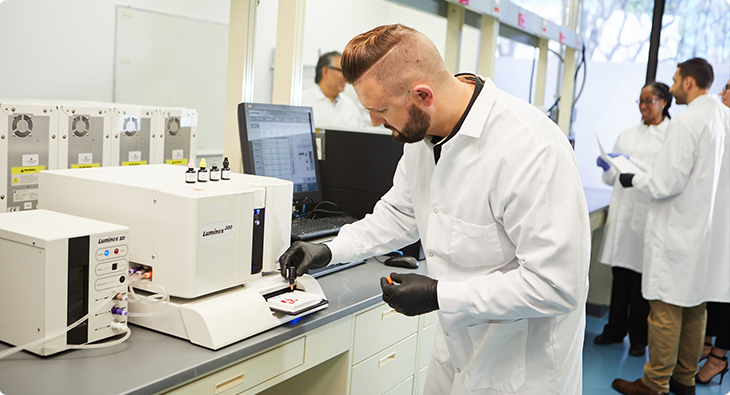Scientists combine anti-drug screening and isotyping into a single assay using xMAP® Technology in a recent study

Assessing immunogenicity, or the potential of a biologic to elicit an immune response, is a critical step in drug discovery and development. In vaccine development, a strong immune response indicates that protection against an infectious disease has been achieved. However, in biotherapeutic development, signs of immunogenicity suggest that anti-drug antibody (ADA) production may lead to adverse events or limit the drug’s efficacy.
Traditional immunogenicity characterization methods are deployed in a tiered strategy, requiring multiple steps to determine the presence and titer of ADAs, antibody isotypes, and the neutralizing capacity of a drug. This process tends to be time-consuming and expensive, especially since it involves repeated freeze/thaw cycles and frequent sample handling, increasing the likelihood of unreliable results. Additionally, in some cases, sample volume may be limited.
However, multiplex immunoassays can combine immunogenicity tests to potentially overcome these obstacles—saving time and costs, preserving sample volume, and delivering high-confidence results.
Multiplexing delivers benefits by consolidating assays while delivering reliable results
In a recent study, researchers used xMAP® Technology to design a multiplex assay from two separate immunogenicity assays to simultaneously identify and isotype ADAs in humans who received Humira®, a TNF inhibitor with a well-documented immunogenicity profile that is commonly used to treat rheumatoid arthritis and other inflammatory disorders.
To evaluate the multiplex assay, scientists screened and isotyped 50 serum samples from healthy individuals and 20 rheumatoid arthritis patients that had never received Humira®. For screening, a bead set was coupled to Humira® and was then used to capture ADAs from the samples. For isotyping, human ADA isotypes were evaluated by coupling mouse isotype-specific capture antibodies to a unique bead set. The coupling confirmation test showed a high level of Humira® on the bead surface—with a median fluorescence intensity (MFI) of 26,923—and high MFI values for the isotype-specific bead sets and their respective human control antibodies as well.
Ultimately, this study demonstrates how multiplex technology can help streamline the traditional tiered approach for immunogenicity studies while reducing hands-on time and preserving both sample volume and integrity. The authors offer a detailed discussion on how their multiplex assay design could be customized, expanded, and optimized, and indicate that xMAP Technology could be valuable for immunogenicity assessment in clinical settings.